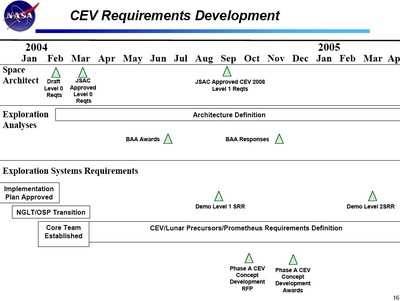Modular, Open Approach Enables Easy, "Plug-And-play"
Upgrades
Astronauts traveling to the moon and beyond may not have to be
rocket scientists to return their spacecraft to full system health
should they encounter a malfunction along the way. They will
receive significant help from a new integrated system
health-management architecture that Northrop Grumman Corporation is
developing for NASA.

The modular, "open" architecture will use a "plug-and-play"
approach -- not unlike that used in today's personal computers --
to interconnect and continuously monitor the functional health of
key spacecraft subsystems such as power, propulsion, life support
and structures. Spacecraft computers will use advanced
health-management software to detect, identify and resolve problems
in these subsystems. If the computers cannot resolve a problem
automatically by reallocating available resources, they will
provide interactive guidance to astronauts on how to "manually"
make the necessary repairs.
Northrop Grumman is developing the integrated system
health-management architecture as part of an Exploration Systems
Research and Technology contract awarded to the company recently by
NASA Ames Research Center in Mountain View, Calif. The
contract is worth up to $26.8 million over a four-year period if
NASA exercises all of its options. The architecture will also
support work that a Northrop Grumman-led team is currently doing to
define design solutions for NASA's proposed Crew Exploration
Vehicle.

"We're developing this architecture, its interface standards and
software algorithms to support not only the health-management needs
of the Crew Exploration Vehicle, but also habitation modules, lunar
rovers and other exploration-system components that it may interact
with," said Erv Baumann, Northrop Grumman's principal investigator
on the project. "Its modular design will allow it to be
upgraded easily as new, more capable health-management software and
hardware subsystems become available."
A "self-healing" space-systems architecture with robust
diagnostic and prognostic capabilities will be particularly
important for extended-duration, deep-space missions where
astronauts won't be close in time or distance to Earth-based
mission managers and subsystem experts. It will also ensure
that any problems in safety-critical systems as well as routine
maintenance, planning and support issues are resolved in a timely,
cost-effective way.
During the first year of the contract, Northrop Grumman will
demonstrate its integrated system health-management architecture
using high-fidelity software simulations of key subsystems,
assisted by NASA's Jet Propulsion Laboratory, NASA Ames Research
Center and the NASA Glenn Research Center.
During subsequent years, the company will replace the software
simulations with progressively higher-fidelity hardware subsystems,
and increase the scale and scope of the exploration vehicles and
systems involved. These demonstrations will ultimately be
conducted at NASA's Johnson Space Center in Houston, Texas, where
functional environmental-control and life-support systems, power
systems and other key subsystem modules will be incorporated into a
demonstration of the integrated health-management system.
The integrated system health-management architecture envisioned
for NASA's exploration systems is the first step in a longer-term
effort to define interface standards that would support the
development of flexible "intelligent modular systems." These
systems would become the fundamental building blocks of
re-configurable spacecraft and lunar surface facilities. Each
intelligent modular system could function as a stand-alone system
or could be linked with other intelligent modular system modules to
create larger, more capable systems.Like an individual intelligent
modular system, this "new" health-management system would be able
to reconfigure itself to share all of its available resources among
member parts.

"The creation of open-architecture standards for
space-exploration systems will also create a more competitive,
accessible market for commercial companies that would like to
develop relevant hardware and software components," explains
Baumann. "Just as in the personal-computer market,
contributions from entrepreneurial 'outsiders' can lead to higher
performance, lower-cost products."
The Crew Exploration Vehicle is the primary human
space-transportation system for NASA's Constellation Systems, an
infrastructure of human and robotic space systems that will allow
humans to travel to the Moon and beyond beginning in the next
decade. NASA is expected to select a prime contractor to begin
design and development work on the Crew Exploration Vehicle in
early 2006.
The integrated system health-management architecture is one of
several Exploration Systems Research and Technology maturation
activities that Northrop Grumman is pursuing to help NASA ensure
that the Constellation Systems architecture is technically
achievable, logistically supportable and economically
sustainable.
For example, the company is developing an insect-like robot to
autonomously inspect and maintain exteriors of spacecraft.
The robot could work in conjunction with the integrated system
health-management software to determine if a spacecraft is damaged
and what resources should be used to make the repair.
The company is also working on a restowable, heat-resistant
"skirt" that deploys around a spacecraft just before reentry to
reduce heat damage to the spacecraft; an engine for a "space ferry"
that would carry people and cargo between the lunar surface and
lunar orbit; small, easily produced phased array antennas for
satellites that use a low-cost electronically scanned array;
and a family of lightweight, self-cleaning, anti-contamination
coatings to address dust-mitigation requirements for future moon
and Mars missions.
 ANN's Daily Aero-Term (04.20.24): Light Gun
ANN's Daily Aero-Term (04.20.24): Light Gun Aero-News: Quote of the Day (04.20.24)
Aero-News: Quote of the Day (04.20.24) ANN's Daily Aero-Linx (04.21.24)
ANN's Daily Aero-Linx (04.21.24) Aero-News: Quote of the Day (04.21.24)
Aero-News: Quote of the Day (04.21.24) ANN's Daily Aero-Term (04.21.24): Aircraft Conflict
ANN's Daily Aero-Term (04.21.24): Aircraft Conflict





